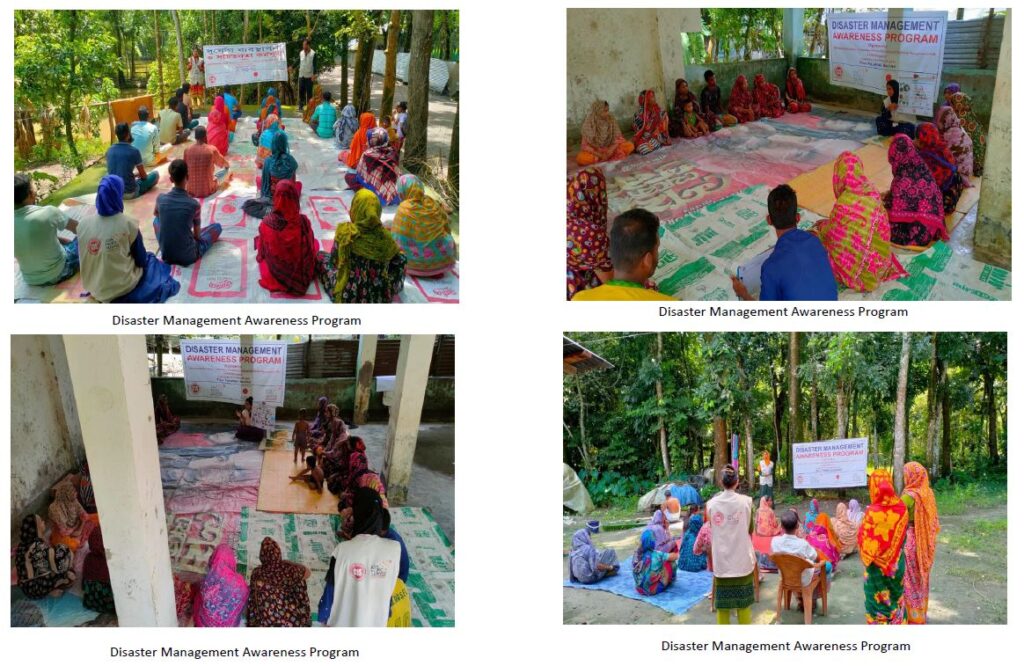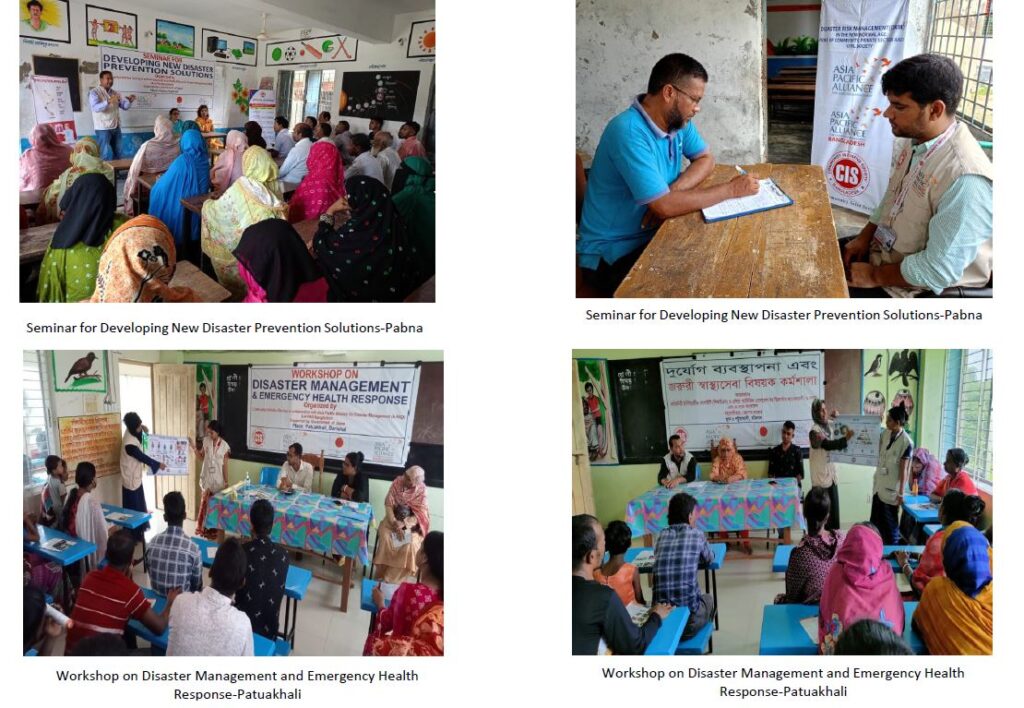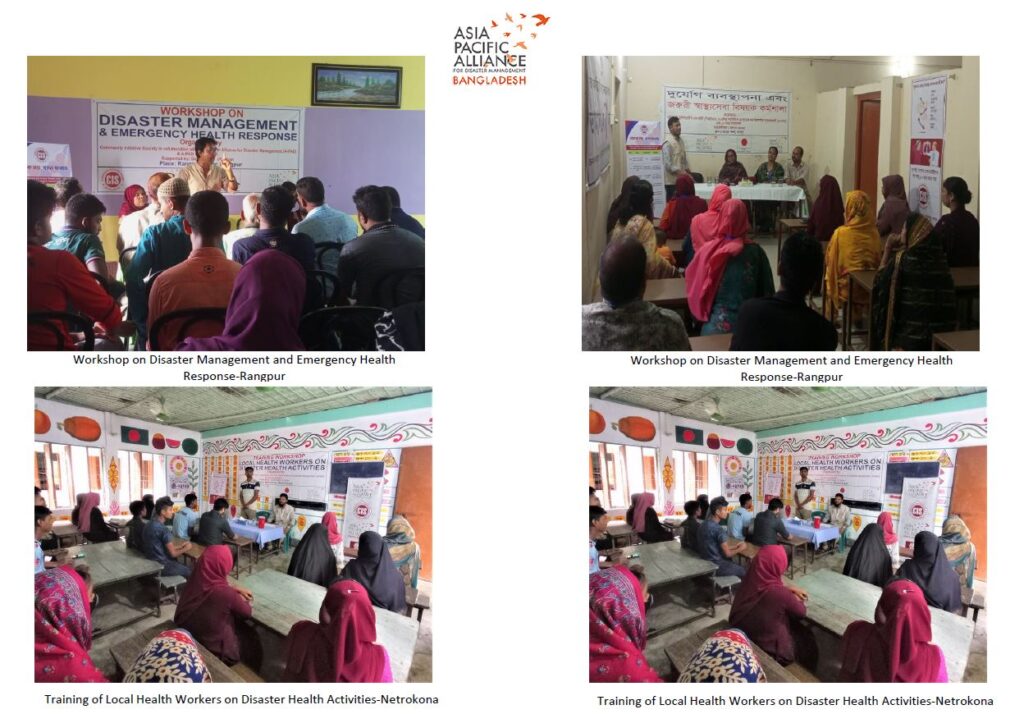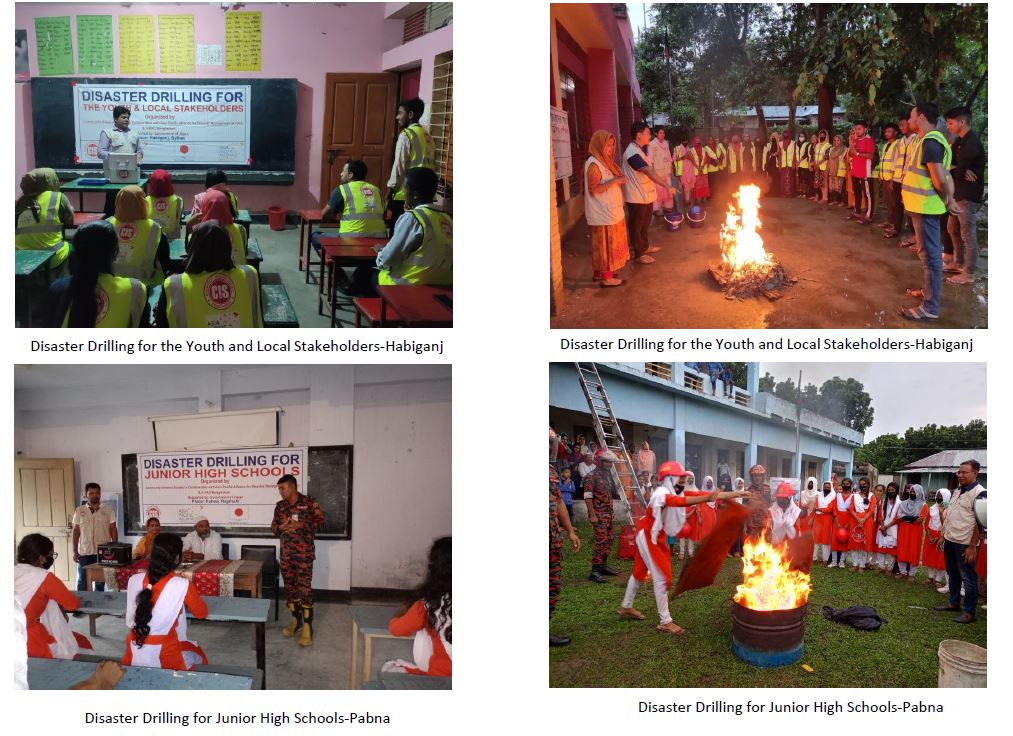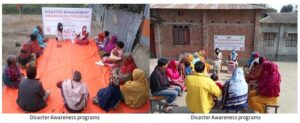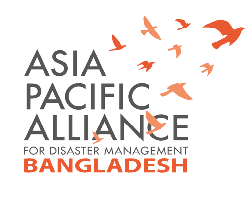Project Title: Strengthening Capacity for Sustainable Disaster Management Network by involving multi-sectoral platform Project Period: 17 January, 2023 – 16 January, 2024 (12 month)
- Project Activities and Accomplishments
Bangladesh is one of the most vulnerable countries to natural disasters and, due to climate change; we are facing natural disasters almost every year. Combined with the country’s geographical location, topography, and dense population, disaster events often result in high loss of life and economic loss, though Bangladesh has been successfully reducing the loss of human lives over the years. The frequency and intensity of natural disasters have increased in recent years due to climate change. The climatic events have serious consequences on broad agricultural sectors, food security, water, health, and sanitation and leave serious impacts on the life and livelihood of the communities. But so far we have limited disaster risk-related data to understand the depth of household and population characteristics and loss sustained by the community at the household levels.
A-PAD Bangladesh started the project in January 2023 and presently continues it on 17 January 2023 to build up capacity for disaster management. It communicates with the different sectors like the local community, community leaders, stakeholders, and GOVT. officials continuing training on disaster management. To hold a training program A-PAD Bangladesh staff organized small community meetings to share ideas on disasters and introduced them about A-PAD Bangladesh activity. A-PAD Bangladesh working 8 divisional areas.
There are 1 health workers in each divisions whose are doing home visit and aware the local community about basic disaster awareness. The health workers gave basic ideas about disaster management. A-PAD Bangladesh working at the rural areas. If there would be any directions or announcement from GOVT. or any disaster related news has been published the health workers delivered the message to the local community. Total 4,813 persons were benefited from A-PAD Bangladesh on September 2023.
A-PAD Bangladesh attended coordination meeting at the 8 divisions in Office of Deputy Commissioner. At that meeting different NGOs had joined and explained their activities. Besides this what will be the next activities of the GOVT. and NGOs were discussed at that meeting.
1. To manage the emergency disaster management coordination centers in disaster-prone areas (Outcome 1) The disaster management coordination center in disaster-vulnerable areas established in this project (3 year project) functions as a disaster response base in each region, and contributes for preventing the spread of health damage to local residents and community-led disaster risk reduction measures. | ||
| Activities | Outcome Indicators to Measure Results: | Project Status: Achievements vs Outcome: If the activity is behind schedule, please write the reason. |
1-1 Operation of Emergency Disaster Management Coordination Centers Beneficiaries: 10 people x 25 days x 8 divisions x 12 months = 24,000 people 50 people x 8 campaign x 12 months = 4,800 people | 【Indicators of Outcome】 1-1: The disaster response management centers in 8 places (Dhaka, Chattagram, Rajshahi, Khulna, Barisal, Sylhet, Rangpur and Mymensingh division) will be utilized and the necessary equipment for emergency health care will be prepared. We will establish a new emergency disaster management coordination center in Mymensingh division. The center will function as a resource center for sharing information on disasters and will be used as a venue for strategic planning meetings, training and workshops. The staff members including doctors and nurses visit the villages and carry out awareness activities related to emergency health measures, public health and disaster prevention for local residents, and ensure that each local resident takes appropriate preventive measures. | Total of 3,571 people visited the Disaster Management Coordination Center to discuss disaster preparedness and health-related issues. Dhaka: 520 Persons Cox’s Bazar: 425 Persons Pabna: 438 Persons Bagerhat: 418 Persons Patuakhali: 432 Persons Habiganj: 462 Persons Rangpur: 421 Persons Netrokona: 455 Persons Total = 3,571 Persons |
1-2 Disaster Management Awareness program Beneficiaries:15 participants x 3 sessions x 8 divisions x 12 months = 4,320 people | A-PAD Bangladesh conducted Disaster Management Awareness programs at the 8 divisional areas where 386 persons participated. Total 3 times training was organized at each divisional area. Dhaka:15 Participants x 3 Sessions= 45+3=48 Participants Cox’s Bazar: 15 Participants x 3 Sessions=45+5=50 Participants | |
| (Indicator: number of visitors, record of services provided)
1-2: The PCR test lab installed in the previous project will continue to operate. In the first year of the project, testing will be conducted only for COVID-19. From the second year onwards, it will be expanded to other infectious diseases (tuberculosis, measles, hepatitis) according to the needs of local residents. (Indicator: number of tests, report of test results) | Pabna: 15 Participants x 3 Sessions= 45+2=47 Participants Bagerhat: 15 Participants x 3 Sessions= 45+3=48 Participants Patuakhali: 15 Participants x 3 Sessions= 45+2= 47 Participants Habiganj: 15 Participants x 3 Sessions= 45+3= 48 Participants Rangpur: 15 Participants x 3 Sessions= 45+5=50 Participants Netrokona: 15 Participants x 3 Sessions= 45+3=48 Participants |
1-3 Operation of PCR lab Beneficiaries: 15 people x 25 days x 12 months = 4500 people(Monthly Goal: 15 persons x 25 days = 375 persons) |
A-PAD Bangladesh established PCR Lab for COVID-19 test. In Bangladesh number of fever patients has increased in number. In September 2023 total 620 COVID-19 test has been done | |
2 Strengthening the disaster response platform network (Outcome 2) A-PAD BGD, NPF for disaster reduction and disaster response through collaboration between multi-sectors, will be established and expanded, and the disaster prevention and disaster capacity of its member organizations will be strengthened. | ||
2-1 Network partner meeting Participants : 100 people x 5 villages x 8 divisions = 4000 people | 【Indicators of Outcome】 2-1 Strategies, mechanism and action plan meeting among networking partners and local communities will be held to support the building of disaster cooperation framework.
2-2 For the aim of awareness and increase the knowledge on disaster preparedness and management among the local community, we will organize different rally and meeting on the disaster preparedness and SDGs related | A-PAD Bangladesh organized Network Partner Meeting at Bagerhat. 10 September 2023, , Total Participants 100+3 11 September 2023, , Total Participants 100+1 13 September 2023, , Total Participants 100+5 14 September 2023, , Total Participants 100+7 16 September 2023, , Total Participants 100+2
The network partner meeting is to share ideas to create a plan for Disaster Management. The workshop was held on 10,11.13,14 and 16 September 2023 in doing so Networking partner meeting is designed to surface and address any factor |
| national/international days like 05 November World Tsunami Awareness Day, 13 October Disaster Risk Reduction Day, 22 April Earth Day and 16 December Victory Day (National).
2-3 For the aim of strengthening of partner organizations, disaster risk reduction (DRR) training will be held. The training contents includes community-based disaster risk management, planning DRR strategies, and risk analysis that effectively identifies hazards, capacities and vulnerabilities. (Indicator: Partner organizations)
2-4 In this seminar, participants from various fields will be invited to exchange opinions and discuss ways to discover innovations related to DRR proposed by community residents and local companies and realize ideas and inventions. (Indicator: To create innovative solutions, we aim to create a successful model for disaster response by combining technology and knowledge that transcends fields and innovating)
2-5 The international symposium will be held in Dhaka to widely share the cooperation between multi-actors | or issue to successful Disaster Management. This training focuses primarily on outcomes that are important to the implementation of the Project. The objective of the Networking Meeting is to seek strategic ways to improve the coordination role of Sarankhola, Bagerhat in directing and ensuring the effectiveness of disaster risk reduction and climate change activities. The networking meeting was attended by a local Government NGO Representative, community leader and Teachers. Such knowledge can be leveraged for pre-disaster risk assessment, prevention and mitigation and development. Strengthening disaster risk governance for prevention, mitigation, preparedness, response, recovery and rehabilitation is therefore necessary and fosters collaboration and partnership across mechanisms and institutions for the implementation of instruments relevant to DRR and sustainable development. |
2-2 Disaster Preparedness Campaigns
Participants:100 people x 2 times x 8 divisions = 1,600 people |
| |
2.3 Network Partners Capacity Strengthening (DRR) Participants:30 people x 2 org x 8 divisions x 2 times =960 people |
|
| at the central and regional levels in Bangladesh and the progress of the emergency health response system among participants who are involved in disaster response from inside and outside Bangladesh. International experts will be dispatched from A-PAD member countries to introduce advanced cases of NPF in each country. (Indicator: The international symposium will be held for a total of three days, one day for field trips (field visits), one day for pre-meetings, and one day for international symposiums.) |
|
2-4 Seminar for Developing New Disaster Prevention Solutions Participants:40persons x 8 divisions x 2times =640 participants | A-PAD Bangladesh organized Seminar 2 divisional areas Pabna. 13-14 September 2023, Pabna, Total Participants 40+5 CIS conducted a 2-day seminar in Pabna. The main objective of the Seminar for Developing New Disaster Prevention Solutions is to promote knowledge exchange and collaboration among experts, practitioners, and policymakers in the field of disaster prevention and management. The seminar provides a platform to explore the latest research findings and best practices in disaster prevention, risk reduction, and response, and to identify new opportunities for collaboration and innovation. The seminar can cover a wide range of topics, including natural disasters such as earthquakes, tsunamis, hurricanes, and floods, as well as technological and man-made disasters such as industrial accidents, cyber-attacks, and pandemics. Participants in the seminar can include disaster management agencies, non-governmental organizations, academics, engineers, architects, urban planners, and other professionals involved in disaster prevention and management. The Disaster Prevention Solutions Seminar in Pabna focused on addressing the specific challenges faced by the region, which is prone to flooding, landslides, and other natural disasters. The seminar covered topics such as early warning systems, community- based disaster preparedness, and infrastructure development. |
|
| Through this seminar, the participants can explore new approaches and technologies to improve disaster prevention and management, develop networks and collaborations, and identify potential areas for further research and development. |
2-5 International Symposium on DRR
Participants:200 persons |
| |
3. Strengthening disaster resilience of local communities
(Outcome 3) 3-1 Disaster response capacity building of local community level in Health and hygiene field | ||
3-1 a) ) Workshop on Disaster Management and Emergency Health Response
Participants:40 persons x 8 divisions x 2 times = 640 persons | 【Indicator of Outcome】 3-1 a) Workshops will be held to understand emergency disaster preparedness, health response and hygiene needs in communities, schools and homes and to learn how to respond during emergencies. Networks of stakeholders will be built through the workshop.
(Indicator: Local citizens, Community leaders, Local NGO, Private sector workers)
b) Workshop for healthworkersfrom local organizationswillbeheld to understand emergency |
A-PAD Bangladesh organized Workshop on Disaster Management and Emergency Health Response at Patuakhali and Rangpur.
17-18 September 2023, Galachipa, Total Participants 40+5 25-26 September 2023, Rangpur, Total Participants 40+3
Patuakhali district is one of the disaster-prone areas in Bangladesh. A two-day training workshop on Natural Disaster Management and Health management was organized at Galachipa in Patuakhali District. The training was on Disaster Management and Emergency Health providers. A total of 50 participants joined this training program. On the 1st day of the |
| health and hygieneneeds and learn how to respond to emergencies. The healthworkerswhofinishedthis trainings are supposed to becomemember of disastervolunteerrescue team in the activity. | training program, there was a discussion on what steps can be taken in emergency health care in the event of a disaster. There was a discussion on pre-disaster, during a disaster, and post- disaster management and emergency health care. During the 2 nd -day training program there was a discussion on Participatory rural appraisal (PRA) is a growing combination of approaches that enable vulnerable people to share, enhance, and analyze their knowledge of life and conditions and plan, act, monitor, and evaluate. Participatory Rural Appraisal was first developed in India and Kenya during the 1980s; it has been mainly used by non-governmental organizations (NGOs) working on the grassroots level. Participatory Rural Appraisal emphasizes empowering local people to take an active role in analyzing their living conditions, problems, and potential to seek change in their situations.
Bangladesh has a very dynamic geographic location. Bangladesh is located adjacent to the borders of Indian, Burmese and Eurasian plates and is susceptible to frequent earthquakes. Besides, The country is located close to the very active Himalayan front and ongoing deformation in nearby parts of Southeast Asia exposes it to strong shaking from a variety of earthquake sources that can produce tremors of magnitude 8 or greater. Historical seismicity within Bangladesh indicates that the potential for damaging moderate to strong earthquakes exists throughout much of the country. A huge number of poor people are to dwell in the vulnerable areas of the southern part of Bangladesh. The vulnerability is so miserable that they have to go and settle in the newly accreted land in the Bay of Bengal and its surrounding areas which is |
| health and hygieneneeds and learn how to respond to emergencies. The healthworkerswhofinishedthis trainings are supposed to becomemember of disastervolunteerrescue team in the activity. | training program, there was a discussion on what steps can be taken in emergency health care in the event of a disaster. There was a discussion on pre-disaster, during a disaster, and post- disaster management and emergency health care. During the 2 nd -day training program there was a discussion on Participatory rural appraisal (PRA) is a growing combination of approaches that enable vulnerable people to share, enhance, and analyze their knowledge of life and conditions and plan, act, monitor, and evaluate. Participatory Rural Appraisal was first developed in India and Kenya during the 1980s; it has been mainly used by non-governmental organizations (NGOs) working on the grassroots level. Participatory Rural Appraisal emphasizes empowering local people to take an active role in analyzing their living conditions, problems, and potential to seek change in their situations.
Bangladesh has a very dynamic geographic location. Bangladesh is located adjacent to the borders of Indian, Burmese and Eurasian plates and is susceptible to frequent earthquakes. Besides, The country is located close to the very active Himalayan front and ongoing deformation in nearby parts of Southeast Asia exposes it to strong shaking from a variety of earthquake sources that can produce tremors of magnitude 8 or greater. Historical seismicity within Bangladesh indicates that the potential for damaging moderate to strong earthquakes exists throughout much of the country. A huge number of poor people are to dwell in the vulnerable areas of the southern part of Bangladesh. The vulnerability is so miserable that they have to go and settle in the newly accreted land in the Bay of Bengal and its surrounding areas which is |
|
| blood pressure could worsen due to disruption of routine health services, lack of access to prescription drugs, or environmental conditions. |
3-2 Strengthening disaster response capacities of local communities through disaster drilling training | ||
3-2 a) Women Empowerment and Capacity Building Participants:20 persons X 8 Divisions X 2 Session = 320 participants | 3-2 a)Building women empower and capacity building through improving their knowledge and skills on disaster risk reduction, in order to involve them in disaster planning and policy making. A women’s group will be trained in the field of maternal and child health, hygiene and environment sanitation, nutrition. (Indicator: A women’s group will be trained in the field of maternal and child health, hygiene and environment sanitation, nutrition.)
b) Drilling training session will be conduct to the local stakeholders, youth group and homes and to learn how to respond the fire, flood, cyclone, landslide and earthquake disasters and rescue at the emergencies. To conduct this training session, we will prepare a training manual and a curriculum collaboration with the department of fire service and civil defense of GoB. (Indicator: After the practical training session two disaster volunteer rescue team will be established in each |
A-PAD Bangladesh organized Women Empowerment Capacity Building Training in 2 divisional areas.
03-04 September 2023, Dhaka, Total Participants 20+6 09-10 September 2023, Cox’s Bazar, Total Participants 20+8
Since the frequency and magnitude of occurrence of natural hazards increased unprecedentedly within this century, policy makers, researchers and practitioners have endorsed on innovative disaster risk reduction measures towards enhancing resilience. In achieving this the Community Initiative Society (CIS) implemented ). The Women Empowerment and Capacity Building Training program in Dhaka. to increase disaster prevention awareness, is primarily designed for women in the Dhaka community. The program’s target participants are women in the Dhaka community, particularly those who are vulnerable to disasters due to their social and economic status. These may include women from low-income households, single mothers, widows, and women with disabilities. Due to climatic issue recent we have faced very fire incidents. So a basic information and demonstration on Fire incident prevention can be very useful for women. These training programs were |
| divisional area.)
c) Drilling training session for the public junior high school students and teachers will conduct at the school based focusing self-protection during and after disaster. Manual will be designed for the school children in cooperation with the department of fire service and civil defense of GoB (Indicator: Participated schools will be supported to develop their emergency management plans.)
In order to widely share and disseminate the activities of this project and the experiences and lessons learned through the activities, situation reports and activity reports in the event of a disaster will be published on the A-PAD BGD website. | divided into 2 session. One was lecture based informative and another was demonstration Based. At the lecture session there was discussion on Fire Incidents and type of Fire Smoke. The reason of fire are Old or defective wiring, overloaded circuits, loose connections, faulty fuses, imbalanced electrical loads, and many other electrical or lighting problems can develop that lead to overheating or sparks that ignite a fire. Electrical problems are responsible for: 12% of fires in office properties. As there was Bangladesh fire Service team was also present. They shared some tips which one should follow in case of fire.
CIS Arranged a 2-day training workshop for women on women empowerment and capacity building. Women, Children and the elderly are the most affected during every disaster, so they need proper training. CIS provides training on disaster and basic health knowledge for women. A Women Capacity drill was held at the Monupara Shelter Project. Senior Station Officer of Bangladesh Fire Service & Civil Defense Cox’s Bazar, Md. Anamul Haq and his team were present as the trainer on the occasion, on the first day of the training. He demonstrated how to extinguish cylinder gas and oil fires by cooking. This type of demonstration by firemen can save lives and livelihoods if a disaster happens. He also said that “awareness and preparedness can reduce the damage caused by any disasters,’. He also thanked CIS for organizing such an event. He also expressed that these types of support will be continuing in Cox’s Bazar. On 2nd day of the training program was Health issues. They have demonstrated what to do during cyclones, landslides, and floods. Rules for keeping dry food, how to keep |
|
| safe drinking water, how to rescue vulnerable people, how to give them first Aid what to do in case of emergency moment. |
3-2 b) Disaster Drilling for the Youth and Local Stakeholders Participants : 45 persons x 8 divisions x 2 times = 720 persons | A-PAD Bangladesh conducted Disaster Drilling for the Youth and Stakeholder in Habiganj.
20-21 September 2023, Habiganj, Total Participants 45+5
Natural disasters, including earthquakes, floods, wildfires, and hurricanes, pose significant threats to our community. Youth and local stakeholders play pivotal roles in disaster preparedness, response, and recovery efforts. To address this, CIS organized A DRILLING WORKSHOP on disaster preparedness and DRR activities for youth and local stakeholders to educate, train, and mobilize individuals and groups to respond effectively to disasters. Recognizing the importance of community engagement and readiness, the Disaster Drilling for Youth and Local Stakeholders initiative was conceived. This program aimed to address several critical aspects:
1. Youth Engagement: Youth often represent an underutilized resource in disaster preparedness and response. They possess energy, adaptability, and a strong desire to contribute to their communities. This |
|
| program aimed to empower and educate youth about disaster risks and the role they can play in mitigating those risks.
2. Stakeholder Collaboration: Effective disaster management is a collective effort. Local stakeholders, including community groups, non-profits, government agencies, and businesses, are essential partners in building resilience and responding effectively when disasters occur. This program aimed to foster collaboration and coordination among these diverse stakeholders.
3. Community Resilience: Building resilience within communities involves not only physical infrastructure but also social and human elements. By equipping youth and stakeholders with the knowledge and skills needed to prepare for, respond to, and recover from disasters, the program sought to enhance the overall resilience of the community.
4. Education and Training: The program recognized that awareness and education are fundamental to disaster preparedness. Workshops, hands-on training, and simulation exercises were key components of the initiative to provide practical knowledge and skills to participants.
5. Feedback and Improvement: Continuous improvement is vital in disaster preparedness. The program incorporated feedback mechanisms to |
|
| Schools program on the 12th and 13th of August 2023. The program started with registration by the school students. It addressed the gathering and spoke on the importance of disaster drilling. Netrakona district is a more disaster-prone area. For geographic location and weather conditions, cyclones, tidal floods, erratic rainfall, cold waves, arsenic contamination, and tornadoes are common in this area. Community Initiative Society (CIS) in Collaboration with Asia Pacific Alliance (A-PAD) implementing a Strengthening Capacity for Sustainable Disaster Management Network by involving multi- sectoral Platform. CIS conducted a drilling program in Barhatta, Netrakona on the 23rd, and 24th of September- 2023. On the first day of the meeting, UNO Farjana Akhter Bobi was present as the Chief Guest on the occasion. In her speeches, she said, CIS role along with the CPP role is very important in natural disaster management. She said that this type of demonstration by volunteers can save lives and livelihoods if a disaster happens. Head Teacher of Nischintapur High School, Golam Faruq Ahemd said, Bangladesh is making remarkable progress in disaster management. CIS conducted a training program in Pabna on 24 and 25 September 2023 two days. The training was conducted two days focusing on different topics. Main focus the training is Disaster drilling for junior high school. In the training workshop were discussed what a disaster, What are the types of disasters. 1. How to put out gas cylinder fire at home. 2. How to put out a fire with wet cloth 3. How to put out a fire with a fire extinguisher 4. How to rescue an injured person in an earthquake, 5. How to bandage a person injured in an accident |
|
| for first aid Md Zakir Hossain senior station officer of Pabna fire service and civil defense discussed all this topic. On the 2nd day there was discussion on earthquake and ow to protect yourself if the body catches fire, How to climb down a ladder in case of fire in a building. The exercise was conducted by Pabna fire service and civil defense senior station officer Md Zakir Hossain along with fire service personnel. |
3-3 Update website contents as E-resources for Disaster Management | https://apad-bd.org/a-pad-bangladesh-activity-report-month- of-august-2023/ |
- Challenges
Please write Challenges and its impact upon the project implementation. (Ex.lockdown, Political situation, Curfew)
- Practice in collaborationwithA-PAD Bangladesh Network Partners Please write good practice in collaboration with partner organizations
- Any contributionFunds Received and Grants Applied / Planned and Implemented Projects by CIS including Emergency Response Please write Projects name and its fund resources
- Relationship with Bangladesh Government and Japanese Embassy Please write about Meeting with Government officials
